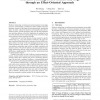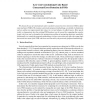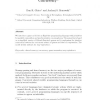2300 search results - page 71 / 460 » Maximally Concurrent Programs |
ASPLOS
2010
ACM
14 years 4 months ago
2010
ACM
Multicore technology is making concurrent programs increasingly pervasive. Unfortunately, it is difficult to deliver reliable concurrent programs, because of the huge and non-det...
DFT
2003
IEEE
14 years 3 months ago
2003
IEEE
We discuss the use of convolutional codes to perform concurrent error detection (CED) in finite state machines (FSMs). We examine a previously proposed methodology, we identify i...
FOSSACS
2004
Springer
14 years 3 months ago
2004
Springer
We introduce a game model for an Algol-like programming language with primitives for parallel composition and synchronization on semaphores. The semantics is based on a simplifie...
PLDI
2012
ACM
12 years 14 days ago
2012
ACM
Efficient communication and synchronization is crucial for finegrained parallelism. Libraries providing such features, while indispensable, are difficult to write, and often ca...
ESOP
2004
Springer
14 years 3 months ago
2004
Springer
t) Peter W. O’Hearn Queen Mary, University of London In the 1960s Dijkstra suggested that, in order to limit the complexity of potential process interactions, concurrent programs...



